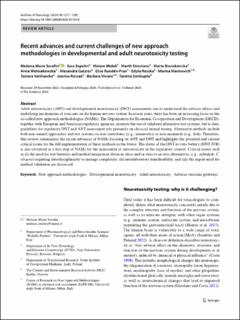| dc.contributor.author | Serafini, Melania Maria | |
| dc.contributor.author | Sepheri, Sara | |
| dc.contributor.author | Midali, Miriam | |
| dc.contributor.author | Stinckens, Marth | |
| dc.contributor.author | Biesiekierska, Marta | |
| dc.contributor.author | Wolniakowska, Anna | |
| dc.contributor.author | Gatzios, Alexandra | |
| dc.contributor.author | Rundén-Pran, Elise | |
| dc.contributor.author | Reszka, Edyta | |
| dc.contributor.author | Marinovich, Marina | |
| dc.contributor.author | Vanhaecke, Tamara | |
| dc.contributor.author | Roszak, Joanna | |
| dc.contributor.author | Viviani, Barbara | |
| dc.contributor.author | Tanima, SenGupta | |
| dc.date.accessioned | 2024-04-09T08:46:19Z | |
| dc.date.available | 2024-04-09T08:46:19Z | |
| dc.date.created | 2024-04-08T13:10:20Z | |
| dc.date.issued | 2024 | |
| dc.identifier.citation | Archives of Toxicology. 2024, 98, 1271-1295. | en_US |
| dc.identifier.issn | 0340-5761 | |
| dc.identifier.uri | https://hdl.handle.net/11250/3125443 | |
| dc.description.abstract | Adult neurotoxicity (ANT) and developmental neurotoxicity (DNT) assessments aim to understand the adverse effects and underlying mechanisms of toxicants on the human nervous system. In recent years, there has been an increasing focus on the so-called new approach methodologies (NAMs). The Organization for Economic Co-operation and Development (OECD), together with European and American regulatory agencies, promote the use of validated alternative test systems, but to date, guidelines for regulatory DNT and ANT assessment rely primarily on classical animal testing. Alternative methods include both non-animal approaches and test systems on non-vertebrates (e.g., nematodes) or non-mammals (e.g., fish). Therefore, this review summarizes the recent advances of NAMs focusing on ANT and DNT and highlights the potential and current critical issues for the full implementation of these methods in the future. The status of the DNT in vitro battery (DNT IVB) is also reviewed as a first step of NAMs for the assessment of neurotoxicity in the regulatory context. Critical issues such as (i) the need for test batteries and method integration (from in silico and in vitro to in vivo alternatives, e.g., zebrafish, C. elegans) requiring interdisciplinarity to manage complexity, (ii) interlaboratory transferability, and (iii) the urgent need for method validation are discussed. | en_US |
| dc.language.iso | eng | en_US |
| dc.rights | Navngivelse 4.0 Internasjonal | * |
| dc.rights.uri | http://creativecommons.org/licenses/by/4.0/deed.no | * |
| dc.title | Recent advances and current challenges of new approach methodologies in developmental and adult neurotoxicity testing | en_US |
| dc.title.alternative | Recent advances and current challenges of new approach methodologies in developmental and adult neurotoxicity testing | en_US |
| dc.type | Peer reviewed | en_US |
| dc.type | Journal article | en_US |
| dc.description.version | publishedVersion | en_US |
| dc.rights.holder | © The Author(s) 2024 | en_US |
| dc.source.pagenumber | 1271-1295 | en_US |
| dc.source.volume | 98 | en_US |
| dc.source.journal | Archives of Toxicology | en_US |
| dc.identifier.doi | 10.1007/s00204-024-03703-8 | |
| dc.identifier.cristin | 2259835 | |
| dc.relation.project | EC/H2020/952404 | en_US |
| dc.relation.project | NILU: 120152 | en_US |
| cristin.ispublished | true | |
| cristin.fulltext | original | |
| cristin.qualitycode | 1 | |

